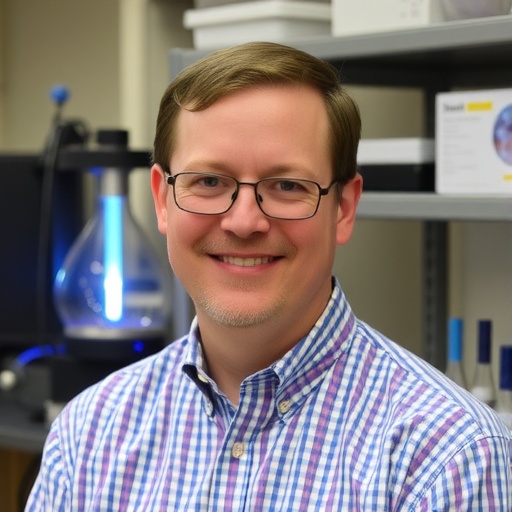In a pioneering stride toward enhancing analytical chemistry, the University of North Florida has secured a prestigious National Science Foundation grant aimed at revolutionizing laser-induced breakdown spectroscopy (LIBS). This advancement promises to deliver unmatched precision and reliability in detecting elemental compositions within a vast array of scientific materials, ranging from environmental samples to industrial substances. The initiative is helmed by Dr. Willis Jones, an assistant professor specializing in chemistry and biochemistry, whose research is set to push the boundaries of current spectroscopic methodologies.
At the heart of this research lies the quest to refine LIBS, a technique distinguished by its utilization of a high-energy laser pulse to ablate a minute region of a sample, thereby creating plasma. The plasma emission spectrum subsequently reveals the elemental makeup of the substance under scrutiny. This method’s compelling advantage is its minimal sample preparation requirements coupled with its capability to analyze solids, liquids, and gases rapidly. However, the inherent challenges within LIBS, such as the generation of noisy data, variable reproducibility, and sensitivity disparities when dealing with diverse matrices, have limited its broader application and trustworthiness.
Dr. Jones and his team intend to address these limitations by designing a bespoke LIBS apparatus tailored to optimize signal acquisition and stability. Central to this enhancement is the integration of novel calibration techniques geared toward trace analyte detection, a domain where current systems frequently falter. Traditional LIBS systems often struggle to maintain consistent sensitivity across heterogeneous samples such as soils and wastewater, primarily due to matrix effects—interferences arising from the sample’s complex composition that skew analytical outcomes.
To tackle these complex matrix interferences, the researchers plan to employ matrix-matched calibration strategies founded on standard dilution analysis (SDA). This approach, previously recognized for its efficacy in spectrochemical analysis, involves preparing calibration standards that mimic the elemental matrix of the sample itself, effectively neutralizing the interfering influence of variable sample composition. By adapting this strategy to LIBS, the project aspires to dramatically enhance the accuracy and reproducibility of metal and trace element quantification.
Another critical element of the investigation is enhancing the data acquisition and processing algorithms that interpret the plasma emission spectra. By deploying sophisticated signal processing and machine learning techniques, the group aims to reduce the intrinsic “noise” generated by plasma fluctuations. These computational advancements will further sharpen the resolution of elemental detection, enabling more robust identification even at ultra-trace levels, which are essential for applications in environmental monitoring and industrial quality control.
Beyond the technical innovations, the project holds substantial pedagogical value. UNF incorporates these cutting-edge LIBS techniques into its core chemistry curriculum, thus equipping undergraduate students with firsthand experience in state-of-the-art instrumentation and analytical problem-solving. By bridging the gap between academic theory and practical laboratory application, the program is preparing the next generation of scientists to excel in rapidly advancing analytical fields.
The potential applications emanating from this research are extensive. Environmental scientists could more reliably monitor pollutant levels in diverse ecosystems; industrial sectors might attain more precise quality control parameters, and biomedical researchers could detect trace elements crucial to understanding physiological and pathological states. Ultimately, the ambition is to set a new benchmark in spectroscopic analysis not only within academic research but across multiple applied sciences.
This NSF-funded initiative reflects a growing emphasis on enhancing measurement technologies that empower researchers to make better-informed decisions based on quantifiable chemical data. By solving long-standing limitations inherent to LIBS, Dr. Jones’s work aims to unlock new frontiers in elemental analysis, catering to multidisciplinary needs from agriculture to environmental remediation and beyond.
Crucially, the custom-built LIBS system emerging from this project will feature modular components adaptable to various experimental scenarios. This flexibility ensures that the advancements are not limited to a narrow subset of samples but rather applicable to a broad spectrum of material types. Such adaptability is expected to foster innovation across numerous scientific disciplines requiring rapid, precise elemental characterization.
Moreover, the synergy between hardware innovation and methodological calibration strategies is a testament to how integrated technological solutions can transcend isolated improvements. By tackling both the physical instrumentation and the chemical analytics simultaneously, the research endeavors to deliver breakthroughs that elevate the reliability and scope of laser spectroscopy as a mainstream analytical tool.
In summary, this ambitious project at the University of North Florida embodies a significant leap forward in chemical measurement technology. Through the strategic refinement of laser-induced breakdown spectroscopy, coupled with advanced calibration methodologies and cutting-edge data analysis, it promises to catalyze transformative changes in the accuracy, sensitivity, and versatility of elemental detection across diverse scientific and industrial fields.
As Dr. Jones and his student researchers push the frontiers of LIBS, the initiative epitomizes the power of academic inquiry fueled by federal investment to deliver solutions addressing complex scientific challenges. The ripple effects of this work are poised to influence analytical standards, research practices, and educational frameworks, highlighting the interconnected nature of innovation, training, and application in advancing modern science.
Subject of Research: Laser-Induced Breakdown Spectroscopy (LIBS) Instrumentation and Calibration Enhancement
Article Title: University of North Florida Leads Breakthrough in Laser Spectroscopy Precision via NSF-Funded Research
News Publication Date: Information not provided
Web References: Information not provided
References: Information not provided
Image Credits: Information not provided
Keywords
Laser spectroscopy, Instrumentation, Analytical chemistry, Calibration strategies, Standard dilution analysis, Plasma emission spectroscopy, Trace element detection, Environmental monitoring, Spectroscopic noise reduction, Laser-induced breakdown spectroscopy, Chemical measurement technology, Instrument design
Tags: analytical chemistry technologyDr. Willis Jones research contributionselemental composition detection techniquesenvironmental sample analysis methodshigh-energy laser applications in chemistryimproving reproducibility in LIBSindustrial substance characterizationlaser-induced breakdown spectroscopy advancementsNSF grant for chemistry researchreducing noise in spectroscopic datarefining LIBS methodologyUNF chemistry department initiatives





